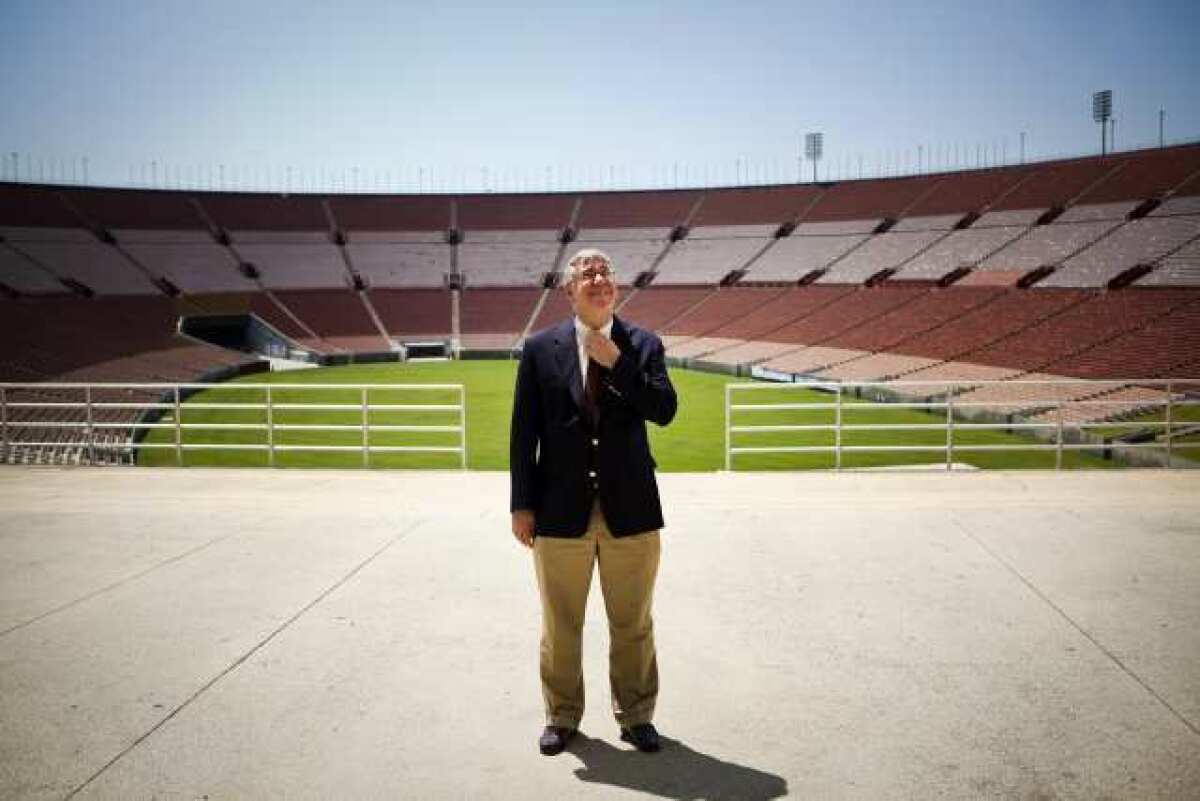L.A. Coliseum Commission officials cash in on unused sick leave

Top officials at the Los Angeles Memorial Coliseum have shown a knack for banking healthy chunks of unused sick leave on the public payroll — in one case, about 35 years’ worth.
Interim General Manager John Sandbrook, a retired University of California administrator, used the sick leave allotment for most of his university career to boost his annual pension by $655 a month for life, to nearly $183,000, UC figures show. The increase represents 418 days — the quota for all but two of his roughly 37 years within the system, which allows 12 sick days a year.
Sandbrook, 62, was hired by the Coliseum Commission to help stop spending abuses at the scandal-shadowed stadium, which is operated jointly by the city, county and state. The man he replaced last year, Patrick Lynch, left with more than nine years of accrued sick time, adding $1,630 annually to his retirement benefits, according to city and state records.
The practice is allowed under state rules but “smacks of pension spiking,” said David Kline, vice president of the California Taxpayers Assn. “I guarantee you will never find a private company that will allow any employee to accrue more than 30 years of unused sick time.”
In an email to The Times, Sandbrook said the unused sick leave was factored into his pension “automatically” under a UC policy that dates back at least 25 years. “I have no other comment,” he said.
Lynch’s attorney, Tony Capozzola, said his client earned the sick leave. “Mr. Lynch deserves the compensation,” he said.
Sandbrook, Lynch and other Coliseum managers — including a third with years of sick time saved — have been embroiled in a controversy that has rocked the famous venue and left its future in doubt.
The Times has reported an array of financial irregularities in how the stadium has been run, including lucrative side dealings, suitcases of cash for a union agent and perks such as luxury cars, massages and golf outings for select staff. Sandbrook kept many of the managers’ perks in place for months after he took the helm.
Most of the managers have now departed. Federal, state and county investigations of their financial affairs are underway, along with a city audit.
Sandbrook, who spent most of his career at UCLA, was earning about $214,000 a year when he retired at the end of 2009 as interim chief of staff to UC President Mark Yudof.
On top of the sick pay that lifted his retirement benefits, Sandbrook had landed more than $50,000 in raises and stipends in his last three years on the job, the period on which his pension was based, according to UC figures.
That amounted to an overall pay hike of more than 30%. At the time, UC was increasing student fees and cutting costs because of budget shortfalls. Sandbrook also cashed out accrued vacation as he left, worth $42,911, which he took in a lump sum, UC records show.
Steve Montiel, a spokesman for Yudof’s office, said Sandbrook’s raises were “in policy” and his salary as interim staff chief was similar to his predecessor’s in that job. As for the store of sick leave, Montiel said Sandbrook “was fortunate enough to be very healthy.”
In his email, Sandbrook said he delayed his retirement to continue working with Yudof at the president’s request.
At the Coliseum, Sandbrook earns $208,000 in salary on top of his pension, receiving a total of about $390,000 a year.
“The guy is a walking example of the need for pension reform,” said Dan Pellissier, president of the California Pension Reform group. Public employees “who are raking in $400,000 in pension and salary — it’s unconscionable.”
Sandbrook’s predecessor at the Coliseum, Lynch, couldn’t save all his sick leave under city rules that govern stadium employees. For years, he had to cash out a portion of his sick leave allowance annually — for a total of $13,793 since 2008, according to city records.
Lynch, 55, quit abruptly last February. His nine years of accrued sick leave penciled out to around six months of extra service credit to his pension, according to the California Public Employees’ Retirement System, which administers the benefits. Lynch’s Coliseum pension is $48,000 annually, including the converted sick leave, CalPERS records show.
It is unclear from city records who approved the terms of Lynch’s resignation — among them a $24,137 payment for unused vacation — because the Coliseum processed it through an automated system. He reported directly to the nine-member commission.
The commission’s attorney, Assistant County Counsel Thomas Faughnan, did not respond to emailed questions about Lynch’s separation.
A third executive, Finance Director Ronald Lederkramer, had amassed sick time valued at close to $11,000 when he left under a cloud last year, records show. As of last summer, he had stockpiled 20 weeks’ worth even though he had received thousands of dollars in payments from the Coliseum in recent years for medical costs that he said were not covered by insurance.
Lederkramer had already been forced to cash out $9,226 in unused sick days from 2009 through 2011. He went on medical leave in September, shortly after City Councilman Bernard C. Parks, a Coliseum commissioner, called for his dismissal. When his employment officially ended in December, he converted his sick-day stash into a lump-sum payment of $10,892.
City Controller Wendy Greuel, however, has withheld that check pending an inquiry. In approving the payout, Sandbrook’s office listed Lederkramer’s status as “retired/pensioned,” but Greuel wants to know if he actually quit or was fired, which would make him ineligible for a sick-leave check.
“We stopped the check from being released until we could understand his termination agreement,” she said. “In light of the recent events at the Coliseum, we have been closely monitoring the payroll … to prevent any fraudulent activities.”
Greuel did not prevent Lederkramer from receiving more than $20,000 in accrued vacation pay because employees generally are entitled to it by law, even if they are fired.
Lederkramer did not respond to a request for comment.
More to Read
Start your day right
Sign up for Essential California for news, features and recommendations from the L.A. Times and beyond in your inbox six days a week.
You may occasionally receive promotional content from the Los Angeles Times.








